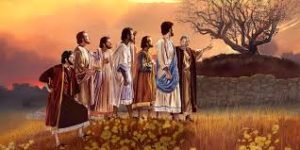Jesus Curses a Fig Tree
Matthew 21:18-19a and Mark 11:12-14
Monday the eleventh of Nisan
Jesus Curses a Fig Tree DIG: When Jesus curses a fig tree, what does the fig tree represent? Why did the fact that Yeshua found nothing but leaves mean it was barren? Did Christ curse all Jewish generations or just that specific generation? How does the acted-out parable of the barren fig tree relate to the cleansing of the Temple (to see link click Iv – Jesus Entered the Temple Area and Drove Out All Who Were Buying and Selling)? Where did Yeshua go immediately afterwards?
REFLECT: If you were a tree, what would help you produce more fruit: Pruning? Watering? Staking? Transplanting? Fertilizing? Why? How might this acted-out parable relate to your relationship with Yeshua? What does producing spiritual fruit mean to you (Galatians 5:22-23)? What does a lack of spiritual fruit in your life mean? When Jesus looks at your life, does He fruit, or nothing but leaves?
It is dawn, and very early in the morning before breakfast. Jesus and His apostles are already on the move, walking purposefully from Bethany on their way back to Jerusalem and the Master was hungry (Matthew 21:18; Mark 11:12).

Seeing a fig tree blooming in the distance, Jesus went down the road to find out if it had any fruit. The fig tree represents Isra’el (Hosea 9:10; Nahum 3:12; Zech 3:10). Just as the presence of fruit on the fig tree represented blessing and prosperity, the absence of fruit was a symbol of judgment and poverty. When He reached it, common property by the roadside, He found nothing but leaves, because it was not the season for figs (Matthew 21:19a; Mark 11:13). It was a perfect symbol of Isra’el, full of promise but producing nothing. It was just a few months earlier in Perea that Christ had spoken of the parable of the barren fig tree (to see link click Hh – Unless You Repent, You Will Perish). Now He made use of this barren fig tree to reinforce the lesson of warning as well as illustrate this acted-out parable.1253 However, the fact that the fig tree had leaves on it gives us a clue. To this day in Isra’el when the leaves come out in late March, they are accompanied with little buds or nodules that are eatable. Micah calls them the early figs (Micah 7:1). Later on in late May or early June the buds ripen and turn into figs. So when the leaves came out, the absence of the buds meant that the fig tree would produce no fruit that year.
The fig tree is an apt symbol of the Jewish people, as the prophet said: “When I found Israel, it was like finding grapes in the desert; when I saw your ancestors, it was like seeing the early fruit on the fig tree. But when they came to Baal Peor, they consecrated themselves to that shameful idol and became as vile as the thing they loved (Hosea 9:10). ADONAI’s loving relationship is beautifully portrayed as finding the best fruit of the early harvest. In Hosea’s day, the prophet lamented that Isra’el did not have the fresh spiritual fruit that God had a right to expect. But, the unproductive fig tree symbolized that Jewish generation’s spiritual barrenness despite divine favor and the impressive outward appearance of their religious system. It was supposed to bear fruit, but it did not; therefore, as a result of making a false profession, like the Pharisees, it was cursed (Jeremiah 8:13; Hosea 9:10-17).1254
Then He said to the fig tree: May no one ever eat fruit from you again (Matthew 21:19a; Mark 11:14a)! If Yeshua’s cursing and drying up the fig tree had been an irritable reaction to disappointment because He couldn’t satisfy His hunger, it would be unworthy of anyone, let alone the Messiah. But Jesus was making a point by means of an acted-out parable. Other examples of acted-out parables in the TaNaKh include Jeremiah, who brought and then broke a clay jar in front of some of the elders of the people and of the priests (see Jeremiah Cz – Judah is Like a Broken Jar), and Ezeki’el, who made and then burned up a model of Zion (Eze 4-5). In the New Covenant, we see this acted-out parable in Acts 21:10-11.1255
In this incident, then, we have Jesus pronouncing the same judgment on Isra’el that John the Immerser had done when he saw many of the Pharisees and Sadducees coming to where he was baptizing, saying to them, “Produce fruit in keeping with repentance” (see Bf – You Brood of Vipers, Who Warned You to Flee the Coming Wrath). Like the leafy tree, they had given external evidence of being fruitful but on examination they were seen to be barren and fruitless. Consequently, judgment had come to that specific generation.1256
And His apostles heard Him say it (Mark 11:14b). To all outward appearances; however, this fig tree remained the same as they moved on down the road toward the City of David. What did the Master mean anyway? They wondered . . . but kept silent.
After this teaching, Jesus walked straight to the Temple. It had been three years since He had turned over the moneychangers’ tables (see Bs – Jesus’ First Cleansing of the Temple at the Passover), but now He planned to do it again. Only this time He has no whip fashioned out of cords, and He is no longer an unknown Rabbi. This episode and the cleansing of the Temple signifies Isra’el’s impending judgment for religious hypocrisy. Isra’el claimed to bear fruit, but there was none.



Leave A Comment